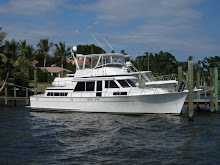Oct 17-18, Pensicola, FL
We moved from the Grand Mariner Marina in Dog River near Mobile, Alabama, across Mobile Bay in a 15 mph north wind to the Gulf Intercoastal Waterway that runs along the Gulf of Mexico from Brownsville,Texas through southern Louisiana and Alabama and the Gulf coast of Florida, to Flamingo, Florida (near the southwestern tip of the Florida mainland). There is a gap of open water between Carrabelle, Florida and Tarpon Springs, Florida.

Muddy water. Eastern shore in the background.
Must be 200 birds back there.
We left the open water of Mobile Bay and entered the sheltered Gulf Interccoastal Waterway where we will travel from Mobile Bay, Alabama, through Pensacola, Ft Walton, Destin, Panama City, Pt St Joe and Apalachacola to Carrabelle, Florida.
Lulu is Jimmy Buffett's 'crazy' sister.
We passed through the communities of Gulf Shores and Orange Beach, (very prosperous) and through Perdido Bay, Alabama. All these communities were badly damaged in Hurricane Ivan in 2004 and have largely been rebuilt and seem prosperous now. There are signs of overbuilding as some condominium and marina projects look relatively unoccupied. A few projects have stopped construction.
Lulu's Restaurant.
look more occupied than most.
Once we left Perdido bay we passed into Florida where we cruised by the Pensacola Naval Air Station, then left the intercoastal and went up into Pensacola Bay and finally arrived in the town of Pensacola. We traveled about 45 miles today.
Spanish explorer Ponce de Leon came ashore on the beach here in 1513 and named it Penzacola after the local Indians who lived here (now extinct).
'Click' on photo to enlarge.
In August 1559, the Spanish King sent an eleven ship fleet, carrying 1500 people to settle here. The settlement failed two years later, but this settlement was the first European settlement in North America. It predated the settlements of Jamestown, Quebec, St Augustine and Plymouth, Massachusetts. Pensacola has had five national flags; Spanish, French, English, United States and Confederate States and changed hands 17 times.
Now rebuilt with floating docks. First class.
All the restaurants and nightlife that was in this downtown area are now gone.
We are staying at the Palafox Marina at the foot of downtown Pensacola. Much of this downtown area was also badly damaged by Hurricane Ivan and was then torn down and the area redeveloped. Our marina is new, as are the nearby buildings, and look nice but there are few people here.
Doesn't Jimmy Buffett have one of these?
On Sunday, we decided to see the National Naval Aviation Museum and spent most of the day there. There are great displays of real aircraft both inside and outside the museum, with a large number of local retired navy people volunteering their time and skills for preservation and restoration. There are many dioramas and displays featuring the Navy planes and Navy men at war. There are several interactive simulators where you can experience (simulated) flight and combat. AAA rates the place a GEM and we agree. We think it is better than the Smithsonian Air and Space Museum in Washington. And that says a lot.
Great they can be preserved.
One of our favorite parts of the museum was the Cubi Bar Cafe where we ate lunch. This part of the museum duplicates the layout and decor of the famous Officers Club located at the Naval Air Station Cubi Point in the Philippines. It was famous for it's Plaques Bar where air and sea crews retired their old plaques for display. This practice began during the Vietnam War and continued until 1992 when the base and club were closed as a result of the damage suffered after the eruption of Mt Pinatubo. After the base and the club closed, more than 1100 plaques along with the bar and tables and chairs were shipped to Pensacola where the museum has recreated the layout and decoration of the bar. The plaques and legends survive and we can enjoy the mementos of this colorful bygone era of Naval Aviation. We felt like we were in a real Officers Club.
The Naval Aviator Museum brings back personal memories for both Linda and Owen. Linda's father, Arthur Kennith (Jack) Horner, was a Navy Officer and Pilot in WW II (on loan from Braniff Airlines) who flew supplies from California to the Philippines. Owen's father, Clark James Schwaderer, was a Navy Officer (LtJG) based in Corpus Christi where the Navy had a big presence in WW II. Linda's brother, Michael James Horner, served aboard the Aircraft Carrier INDEPENDENCE during the Vietnam War. Owen's brother, Charles Bayne Schwaderer, was an Army Officer (Lt) during the Vietnam War and was transported and resupplied by Army and Navy helicopters. We ended our day watching the movie 'Top Gun' on TV. Seemed appropriate.





















0 Comments:
Post a Comment
Subscribe to Post Comments [Atom]
<< Home